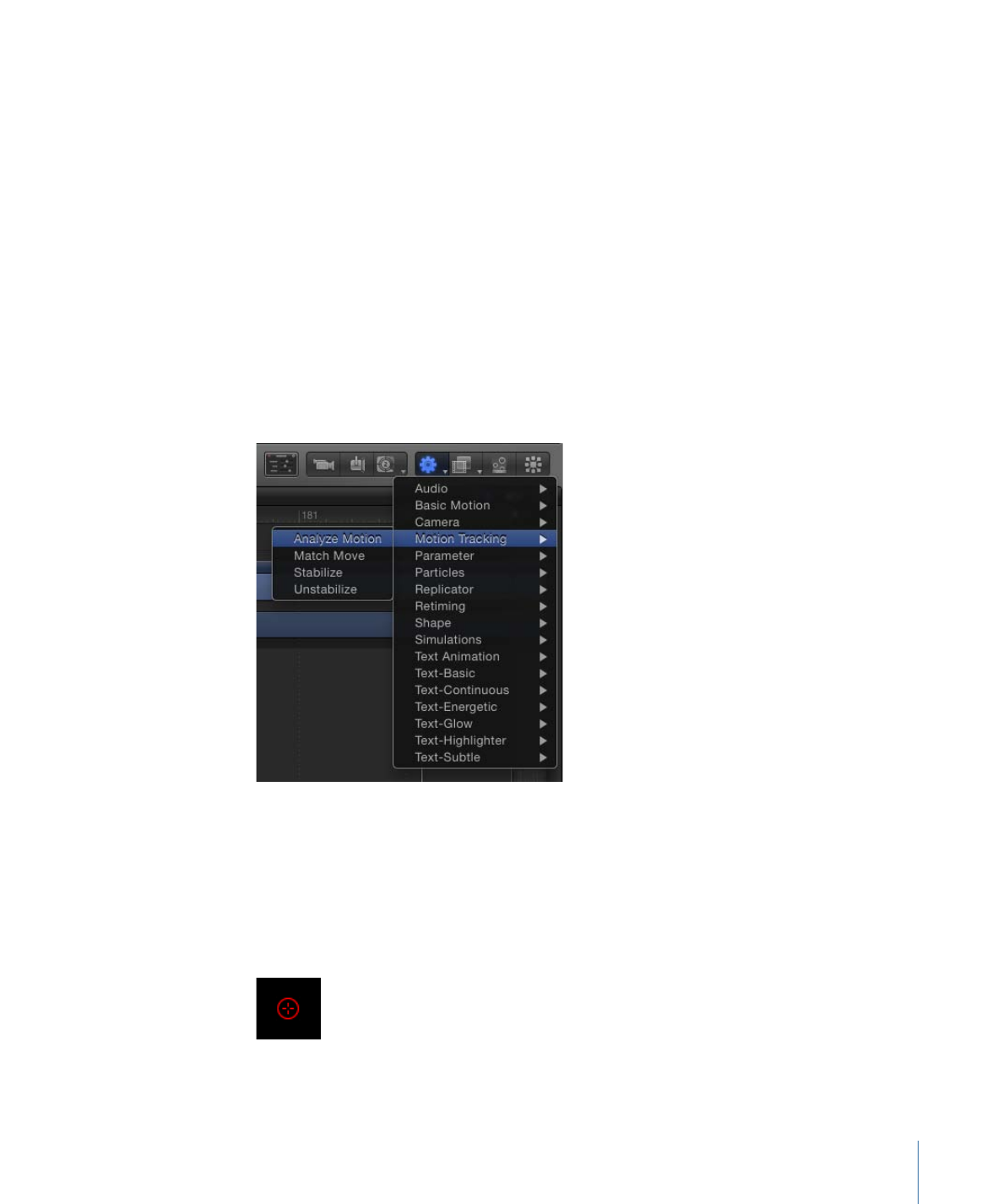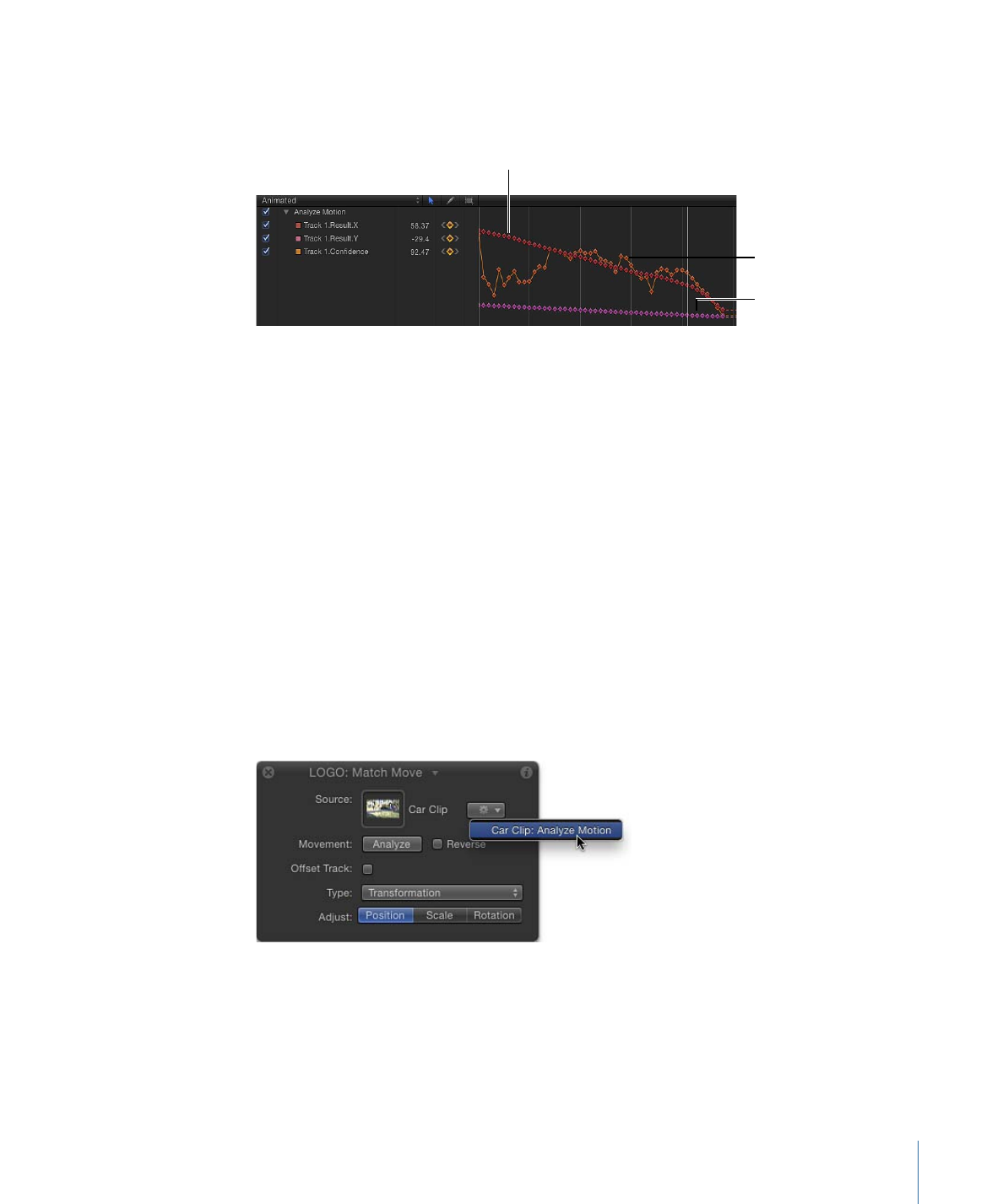
General Motion Tracking Workflow
This section is a general overview of the tracking workflow common to most Motion
Tracking behaviors. The Analyze Motion behavior is used in this example.
The Analyze Motion behavior analyzes and stores tracking data from a clip but does not
transform the tracked object. Analyze Motion data tracks are meant to be referenced by
other tracking behaviors.
For a full description of Analyze Motion parameters, see
Analyze Motion Controls
.
Tracking in one pass rarely yields perfect results. For information on tracking methods
and tips, see
Strategies for Better Tracking
.
To generate a track for a clip using the Analyze Motion behavior
1
In the Layers list, Timeline, or Canvas, select the video object to track, then choose Motion
Tracking > Analyze Motion from the Add Behavior pop-up menu in the toolbar.
Note: You can also select the video object, select the Analyze Motion behavior in the
Library, then click the Apply button in the Library preview area. Alternatively you can
drag the behavior from the Library to the video object in the Layers list, Timeline, or
Canvas.
An onscreen tracker is added to the footage. By default, a single tracker appears at the
center of the footage.
1293
Chapter 22
Motion Tracking

2
Play your background clip several times to determine a good reference point in the
footage, then move the playhead to the frame where you want to start the track analysis.
3
In the Canvas, drag the tracker to the reference point you want to use.
Note: For more information on using the onscreen tracker, see
Adjusting the Onscreen
Trackers
. For more information on selecting a tracking reference point, see
Strategies for
Better Tracking
.
4
To add trackers, click the Add button in the Behaviors Inspector.
Each new tracker is added to the center of the footage.
5
Drag the additional trackers to the reference points you want to use.
6
To track a specific range of frames, adjust the start and end points of the purple tracking
behavior bar in the Timeline or mini-Timeline.
Note: If you adjust the length of the tracking behavior bar, make sure to set your tracking
reference points within the range of the behavior.
7
Click the Analyze button in the HUD or Behaviors Inspector.
When the tracking analysis begins, a progress window opens, and track points appear
on a motion path in the Canvas. The track point at the current playhead position is
emphasized.
1294
Chapter 22
Motion Tracking

The tracking keyframes contained in the behavior appear in the Keyframe Editor. (If the
Keyframe Editor is not visible, click the Show/Hide Keyframe Editor button in the lower-left
corner of the Motion project window.)
Confidence curve
X position curve
Y position curve
Because the Analyze Motion behavior does not transform the source object, only the
tracking keyframes appear in the Keyframe Editor. When using a Match Move or Stabilize
behavior, the tracking keyframes appear as well as the transform curves of the source
object (for Stabilize) or destination object (for Match Move).
A confidence curve is also displayed in the Keyframe Editor. This curve provides a visual
indication of the tracker’s accuracy relative to its parameter settings in the Inspector. The
confidence curve is not for editing purposes.
8
To stop a track analysis, click the Stop button in the progress window or press Esc.
Tip: If the tracker loses its reference pattern, do not click the Stop button. Allow the
analysis to continue for a few seconds. When the tracker fails, the playhead jumps to the
exact frame where the track was lost.
The analyzed track, contained in the Analyze Motion behavior, can now be loaded into
other tracking behaviors (via an Action pop-up menu in the HUD or Inspector of the other
tracking behaviors). In the image below, a track from the Analyze Motion behavior is
loaded into a Match Move behavior HUD.
Note: The Stabilize behavior can only load tracks from other Stabilize behaviors.
1295
Chapter 22
Motion Tracking

Important:
Although the Stabilize behavior’s automatic analysis mode starts from the
beginning of a clip (regardless of the playhead’s position), the analysis of other tracking
behaviors begins at the current playhead position for all workflows. To define a tracking
region, set an Out point for the tracked clip. If you are performing a reverse track analysis,
set In and Out points for your track. To set an Out point, position the playhead at the
correct frame, select the clip, then choose Mark > Mark Play Range Out (or press
Command-Option-O). To set an In point, position the playhead at the correct frame, select
the clip, then choose Mark > Mark Play Range In (or press Command-Option-I).
Loading Data into a Behavior
If the project contains footage or animated objects when a Match Move, Stabilize,
Unstabilize, or Track Points behavior is applied, the nearest footage or animated object
below the behavior in the Layers list is applied to the tracking behavior and appears in
the behavior’s Source well. This data is overwritten when you choose another track from
the Action pop-up menu.
You can assign an animated object or tracking data to a tracking behavior in any of four
ways:
• Choose another tracking behavior from the Action pop-up menu.
• Drag a tracking behavior or footage object to the Source well in the HUD or Behaviors
Inspector.
• Drag an animated object to the Source well in the HUD or Behaviors Inspector. The
referenced animated object is applied as the source for the current behavior. (This
option applies only to the Match Move and Track Points behaviors.)
• Drag a tracking behavior or footage object to the tracking behavior in the Layers list.
The referenced tracking behavior or footage object is assigned as the source for the
current behavior.
Note: To clear a Source well, drag the item away from the well and release the mouse
button.